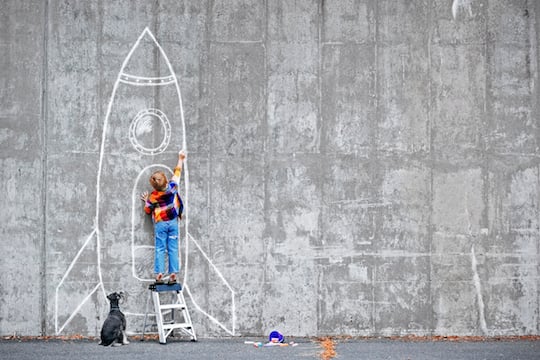The evolution of stock photography in marketing
Share
iStock by Getty Images is celebrating its 15th anniversary this year by looking back at how stock imagery and crowd-sourced content has come to play such an integral role for many professional marketers.
The platform started out back in 2000 as a new way to trade spare images from photo shoots online among designers, but as the digital age has accelerated, the concept has transformed and grown to serve businesses in countless industries. iStock’s global creative community now comprises 155,000 contributing artists from 165 countries, providing marketers and designers with instant, tailored and affordable stock content, to use in everything from brochures and posters to websites and social media.
Marketing chatted to Rebecca Swift, director of creative planning at iStock by Getty Images.
All images courtesy iStock by Getty Images.
Marketing: So we wanted to chat with you about the fact that iStock is turning 15, and everything that’s happened over that time in stock photography – the evolution of it and the big changes it has brought to marketers. Could you start off by taking me through how it all started?
 Rebecca Swift: Stock photography started much much earlier but in terms of stock photography as we know it now, it started in the 1980s when ad agencies mostly were needing sunny blue skies to paste into great big expensive commissions they’d put together when it turned out to be a crappy day. It then moved into the rejects from bigger shoots and photographer archives. It was a very kind of submissive relationship with the photographers, so the stock library as they were called then would accept boxes of analogue images, then sift through them and make some kind of catalogue out of them. Then as the need for more and more images emerged, different technologies came along and the world in general became much more interested in photography as consumer photography became more affordable and we all started taking snaps of our family occasions, portraits of weddings and that kind of thing. So the desire for more images grew, and unfortunately client budgets didn’t grow alongside the need. Stock photography became more and more important, as the arsenal in a marketer’s or an advertiser’s creative bucket, I suppose.
Rebecca Swift: Stock photography started much much earlier but in terms of stock photography as we know it now, it started in the 1980s when ad agencies mostly were needing sunny blue skies to paste into great big expensive commissions they’d put together when it turned out to be a crappy day. It then moved into the rejects from bigger shoots and photographer archives. It was a very kind of submissive relationship with the photographers, so the stock library as they were called then would accept boxes of analogue images, then sift through them and make some kind of catalogue out of them. Then as the need for more and more images emerged, different technologies came along and the world in general became much more interested in photography as consumer photography became more affordable and we all started taking snaps of our family occasions, portraits of weddings and that kind of thing. So the desire for more images grew, and unfortunately client budgets didn’t grow alongside the need. Stock photography became more and more important, as the arsenal in a marketer’s or an advertiser’s creative bucket, I suppose.
I came into the industry in the mid-90s when it was really starting to ascend, and we were actually starting to get photographers to shoot directly for us. We’d kind of moved the business away from just accepting what came in to actually directing what our photographers shot for us, and actually making a very tightly-controlled and very usable catalogue of images. Then obviously digital technology came along and the whole thing just exploded – not only in terms of the number of images that were produced, but the number of images that we as a business could put out there – we were no longer constrained by print technology. In the very beginning, we were constrained by bandwidth, and as time’s gone on, the ability to put more and more images out into the web has enabled more and more photographers to get involved.
Obviously a very interesting and exciting development of that is user-generated content and that’s really where iStock was the first to understand that there were more photographers in the world, not classically trained or technically brilliant, but people who enjoy taking photographs and wanting to share them. iStock started as a file sharing site and found a need in the market for cheap, user-generated content and kind of exploded from there. So we as a business at Getty Images have the premium imagery on Getty and iStock is the crowd, it’s the community.
M: So you mentioned before about creating the images as opposed to just collecting them from photographers. Could you just run through the business model in a little more detail so I’m clear?
My very recent history is iStock but my career history is Getty Images, and we pioneered the creative research model, which is the one that we still use now, which is, doing a lot of research into how images are sought, how images are used, looking into aesthetics, subject matter, understanding what our customers enjoy looking at themselves and what the competitive landscape looks like. When I say that I mean, what does the finance industry look like? What does the chemical industry look like? What does the retail industry look like? And using that intelligence to really drive the direction that we then communicate out to our photographers. We have many different models that we work on now. When I first started it was a handful, a few thousand photographers, and now we’re dealing with 150,000. So obviously the way you communicate with them is very different, but we still have one-to-one art directing – the traditional model, with our top guys or the guys we’re really trying to push onwards, we have relationships with our guys who just want to be tweeted at or Facebook posted at, and then we have obviously the guys who are kind of underneath that who are still learning, and want to pick up tricks and things, and that’s how we run our iStockalypse program, which is an education program. We go to different cities and allow them to shoot with models and in locations.
But my role is basically to direct and give anyone who’s interested in participating in photography or illustration or video the opportunity to produce something that a client will find attractive. So rather than just uploading 300 images of your dog or your baby, or flowers – uh, flowers – giving them data on: why does a corporation come to iStock? What are they looking for? What are the emotions they’re trying to convey? What are the concepts they’re trying to evoke from their images? So I’m kind of like the bridge between the customer and the actual photographer themselves.
M: Talk me through a little bit about your clients. I’m imagining a lot of people who would be coming in and subscribing and downloading images are brands and marketers, would that be right?
RS: Yeah, and that’s been the fascinating thing about working with iStock actually, because when I was only working on Getty I’d deal with marketing departments client-side or agencies or the media (magazines, newspapers, TV, production houses), but now with iStock it’s literally everyone, from multinational ad agency networks down to a small community group who are putting on a jumble sale in a local community hall. It’s such a broad mix, and I absolutely love that. We’re enabling somebody who’s putting a coffee morning together for charity to produce lovely posters for their event, or a local hairdresser to compete with the national hairdresser chains. So its literally everybody. Whenever I’m asked, ‘Who are your clients?’ I’m like, ‘You just name a company and they’re probably our clients’.
M: That must be a challenge in a way. How do you grapple with making decisions on what to offer, if you’ve got everyone out there that’s potentially a client?
RS: Actually for my own career motivation and interest you would’ve thought that it’d gotten boring doing the same kind of thing, especially because of the reputation of stock is that it’s just generating the same old stuff over and over again. But actually it’s not, it’s always changing, there’s always a new business that comes about. And some of the businesses now – technology, services, web design, search – those businesses weren’t around five or 10 years ago. So we’re now having to find images that represent those businesses for those companies who are promoting themselves to their clients. It is absolutely fascinating, and it is always exciting to see something emerging and something new coming through that we can then use as an idea to produce different images.
M: Definitely. And I guess there are many companies out there using stock images that probably in the past would not have even considered using images at all in their communications, just because it’s available now.
RS: It’s cheap. When I first started, stock was cheaper than commissioning, but it wasn’t cheap. It was a tightly-controlled, rights-managed model, where you had to negotiate the rights for the image and that had cost implications. Now you can license royalty-free images, so you can use them how you want, to a degree, and you’re looking at a few dollars a piece. Because supply’s increased, prices have gone down and that benefits the customer because not only do they have more choice but hopefully they have the budgets that they can use more images across more platforms. No one can possibly produce that amount of images themselves, so stock’s filled that gap.
M: You mentioned before about how there’s a negative reputation around stock images. What are your thoughts around that reputation of the stock image industry?
RS: I think the stock industry has a reputation because there is bad stock around. My argument always in that situation is, if our customers stop buying it, our photographers will stop producing it. It’s not until that happens that that stuff will go away. And unfortunately no one will take responsibility for using it, they just want to kind of criticise the stock industry for producing it, so it’s a vicious circle. Again, I can’t control everything that comes into our collection, but the stuff I do control is not that type of imagery.
M: You’d be striving to be high quality, I’d imagine?
RS: That’s right, we’re pushing forward. I think it’s all visible, it’s all out there, so you do see the bad as well as the good; you see the whole range. And we’re quite happy to laugh at that stuff as much as anybody else – who doesn’t love an old-fashioned stock shot? I mean, it’s absolutely glorious. I totally get that criticism. But again it goes back to this conversation about cliches, and stock perpetuating cliches, well you know, there are a lot of industries that perpetuate cliches. The fashion industry’s probably the worst cliched industry in the universe in terms of how they depict clothing and whatnot.
M: Nice to hear some honesty there. So what about legal issues? Being a global company, what do you do about copyright across borders and that kind of stuff? Could you talk just generally about that?
RS: That’s really not my forte, but as a business we take our responsibility as the largest content agency very, very seriously. We’re very much involved in copyright law, intellectual property, making sure we have the best-model releases, we have the most stringent guidelines about what we will accept, in terms of whether an image looks like another image or whether there’s branding in an image. We have to make sure to protect our contributors, and we take on the responsibility of that once we put an image onto our site. Our legal team are involved in all sorts of campaigning the the US and Europe on the whole right click thing of imagery online, putting laws into place.
M: Could you explain the right click thing?
RS: You know this behaviour that we have now, we go onto Google images and right click on an image and we put it in a presentation, or whatever, just download it. That is very easy, but whether you should actually do that and whether you should use that for your own purposes is a whole other discussion and a legal conversation. We’ve done a lot of work around that.
M: In the media there’s a debate around the business model behind charging for online content. Has there been a parallel issue in terms of changing people’s mindsets to get them to pay for images online?
RS: Yes, and I think it’s a cultural, maybe even a generational shift that needs to happen. We went from the web allowing us to get access to all this wonderful information and wonderful images and videos etcetera, to now we actually have to think about how we police that, because it could actually be very chaotic and get completely out of control. Anyone who then is an author or a maker or a creator or something is basically allowing their content to go onto the web and be used by everybody, and that’s not right. We wouldn’t allow that to happen to a book or a hard copy magazine, or a painting, so I think the next generation of whatever the web becomes will be much more aware of who has made something, who has authored something, and the importance of that.
Then I think paid content will emerge out of that. but we are in this weird flux state, and we can certainly see that with photography. We’ve gone through a period of 10 years where the price has just gone down and down and down and down, and that can’t keep happening. At some point there has to be a reason for it to come back up again. I think quality and expertise and effort will be rewarded… ‘She says looking into her crystal ball’.
M: Interesting, you can’t be giving stuff away for free. Thanks for your time.
RS: You’re welcome, good to speak to you.
Since this interview, iStock has provided the following statement on licensing issues:
We work with tens of thousands of photographers the world over to capture and license outstanding images, and protecting copyright and the livelihood of our photographers and contributors is a top priority – these photographers depend on license revenue to earn a living and fund the creation of new works. Protecting the creative process is essential for photographers and customers – and the community at large.
Our aim is to approach infringers as customers and to educate them – and anyone else who is new to licensing – about how to use imagery legally, whether through proper embedding or licensing.


















